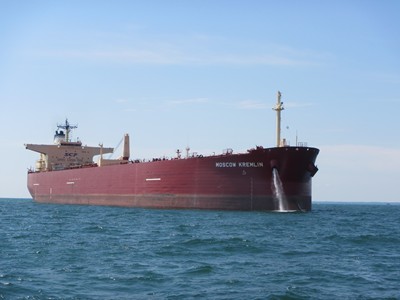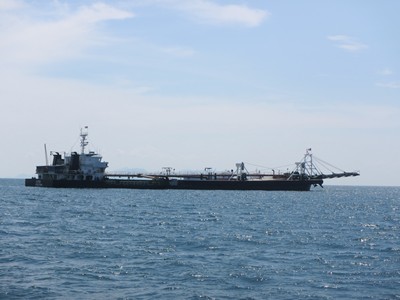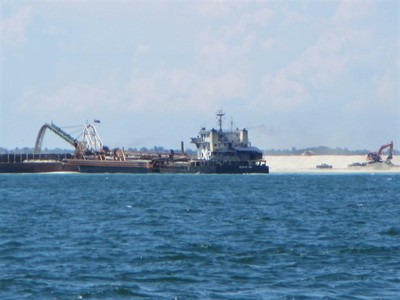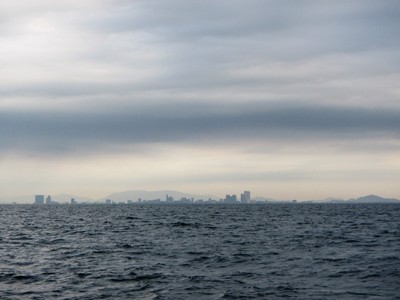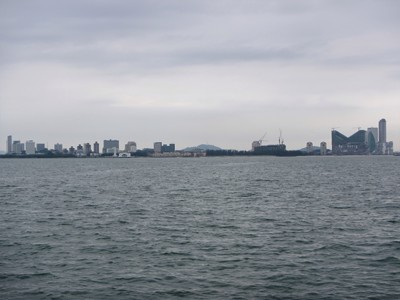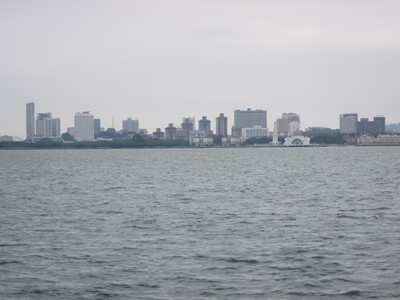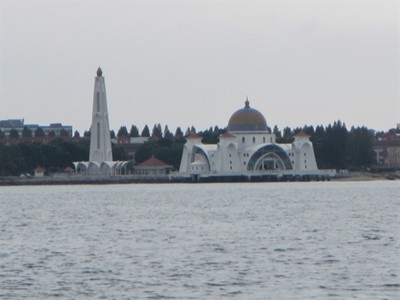Overnight to Melaka (Malacca)

|
02:10.983N 102:14.262E Sunday 29th October 2017 Distance run: 115 nm As our passage to Melaka would take us about 22 hours, there
was no need to leave early yesterday morning. The aim was to leave with
enough time to get to the shipping lanes in daylight, spend the night hours on
the edge of the shipping lanes, where we would hopefully avoid all fishing
boats and nets, and then leave the shipping lanes next morning in daylight and
head in to Melaka. So we had a lazy morning and went for coffee overlooking the
marina where we could watch the comings and goings of the rally fleet.
Many boats had already left by the time we woke up this morning, and we assume
they will stop at Pulau Pisang, about 40nm away, for the night.
Typically, the wind had picked up for the first time in a week, and it looked
like we might have fun getting out of our berth, especially as a Lagoon 44
catamaran had parked next to us yesterday afternoon, leaving little room for manoeuvre.
But as we singled up the lines and made our final preparations to leave, the
wind suddenly dropped to nothing. Perfect! The engine was on in a
trice and we were off. All went to plan, and we had some wind to sail by for several
hours, though the sea was a bit lumpy at times with wind against tide. We
picked our way between many anchored ships at the exit of the Johor Strait and
turned the corner, heading north into the famous (or should that be infamous?)
Malacca Strait.
The Moscow Kremlin was a long way from home. A
sand dredger heavily laden with sand, waiting to offload.
The bow protrusion is for offloading the sand. This
dredger is offloading into the land reclamation works off Johor. The plan seemed to be a good one as we kept to the edge of
the shipping lane, as all the commercial shipping must display correct lights
and transmit an AIS signal. This meant that to our port side it was easy
to see where they were and how fast they were going, all in the same direction,
approaching us from behind. The Malacca Strait is one of the busiest
shipping routes in the world, being the main route between the Indian and
Pacific oceans, and indeed there was never a gap in the traffic in either
direction the whole night. To our starboard side it was somewhat more exciting, with fishing
boats with odd lighting arrangements or none at all, tugs with unlit tows, and enormous
sand dredgers passing close by in either direction. Sometimes we were
sandwiched between two large ships, but at least we could see them! A couple of storms passed over us during the night, with
thunder, sheet and fork lightning, rain and wind, just to keep it
interesting. The usual collection of electronics went into the oven for
protection, but the night passed without incident. We left the shipping
lanes as planned an hour or so after dawn, and arrived at the anchorage at Melaka
a couple of hours later.
Our first view of the Melaka cityscape under a still
stormy sky. The
high rises of modern day Melaka become clear as we approach.
The “floating Mosque” to the right of centre
does not really float, but is built on stilts, and at high tide it looks as if
it is floating. We arrived at low tide and the stilts are still visible. We anchored in water even shallower than at Gili Bodo in
Indonesia, with just half a metre under the keel. It was low tide and set
to rise by another half a metre, so no worries. The shallow water started
quite a long way out, created by spread of sand from the neighbouring land
reclamation works, so we had to go very shallow to get some protection further
in. We have yet to understand why there are so many land reclamation
schemes here in Malaysia, as they have so much land inshore. Perhaps we’ll
get lucky one day and ask someone who actually knows! Once the anchor was set, we tidied up, had a late breakfast
and then a nap before heading ashore to explore the city that was once the
centre of trade in South East Asia, during the time of the Sultanate from the
13th to the 16th century. It was later taken by
first the Portuguese (1511), the Dutch (1641), the British (1825), the Japanese
(1942), the British again (1945). It was not until 1957 that the country
of Malaya, now Malaysia, gained independence from the British. We were
looking forward to seeing the old town, where some of the houses date from the
18th century. |
